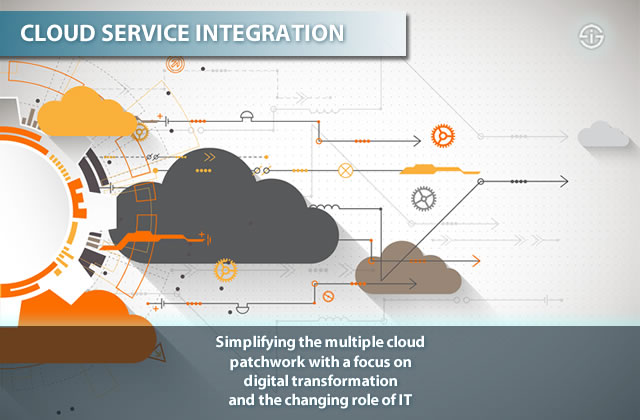Cloud computing has been around for quite some time now. Yet, things change fast: public cloud adoption is on the rise, also for more critical workloads, and cloud infrastructure and cloud services rapidly become an inherent part of IT and digital transformation strategies.
Given the increase of hybrid cloud and the multi-cloud reality in many larger organizations, cloud service providers are taking on a role as cloud service integrators in a reality where cloud orchestration is becoming a key role for companies.
The growing adoption and use of more and more clouds within one organization mean that the role of the CIO and IT is changing and needs to change
Such integration initiatives have a cloud management application on top and go by different names such as cloud of clouds. They aim to enable a seamless cloud experience, which in turn enables customer to focus on their core business, optimization, innovation and of course digital transformation efforts. The benefits: organizations can rapidly and easily access and manage all their cloud services, regardless of the when and where.
In an interview, which we conducted for BT, the company’s Robbert Vogel explained some of the evolutions with regards to cloud, its evolving realities and new cloud drivers and strategies at the occasion of BT’s cloud of clouds solution launch. An adapted extract.

Cloud service integration – meeting the changing reality of the cloud, the CIO and IT
Can you start by sharing some of the takeaways from the cloud report BT conducted with Cisco and IDC, and how they relate with the role of IT and the cloud of clouds approach?
Robbert Vogel: We find that companies don’t just think about making the move to the cloud but they’re actually doing it. Over 65 percent of our customers today already embrace some form of cloud strategy. This ranges from cloud solutions for specific applications to entire cloud deployments.
The growing adoption and the use of more and more clouds within one organization have significant consequences. It means that the role of the CIO and of IT is changing, and needs to change.
The drivers to move more to the cloud have multiplied significantly
Infrastructure is now something that can be sourced from the cloud, whereby the cloud provider takes care of the infrastructure and enables IT and the CIO to focus more on the business, as they’re increasingly asked to.
From the service provider perspective, it’s our role to facilitate the IT departments to make this shift. The increasing importance of the business needs regarding technology and digitalization shapes how we serve our customers. We bring it all together with a clear strategy across our portfolio: Cloud-of-Clouds.
Shifting cloud adoption drivers: from flexibility to shorter time to market – the impact of digital transformation
What are the various drivers of accelerating cloud adoption and how did they change according to the mentioned research and yourself?
Robbert Vogel: The drivers to move more to the cloud have multiplied significantly. It’s about more than just saving costs and increasingly about a change of the IT environment to be faster and better able to support the business needs.
Organizations look at flexibility and a shorter time to market; drivers that are business-oriented and about digital transformation. I see it as a positive development that customers are increasingly looking at how technology can be leveraged to achieve revenue growth, and not just as a means to cut costs.
We also recognize that Lines of Business are more involved in technology choices. We see for example marketing taking the lead – e.g. on how technologies can enhance customer insights and engagement, and IT engages with them and supports on cloud based environments and applications.
How does all this relate to the need for the cloud of clouds and cloud service integration approach?
Robbert Vogel: Following upon this market analysis we see that the IT landscape of a company consists of a lot of platforms and clouds and expect that within 2 years 90 percent of our customers will have multiple clouds, including their in-house clouds.
Organizations are increasingly looking at how technology can be leveraged to achieve revenue growth and not just as a means to cut costs
As IT moves more to the business and looks at each workload and requirement from the business, they understand that there are specific platforms for specific workloads.
The requirements of HR are different from that of marketing and for each one it’s about finding the right cloud. This leads to a growing patchwork of clouds in the IT environment of an organization and it’s this reality that has led us to develop the Cloud of Clouds portfolio and its infrastructure orchestration.
Cloud service integration – moving beyond cloud services and cloud brokerage into the business process
There is a cloud management platform layer on top, which you call the Compute Management System. Can you tell us a bit more about that?
Robbert Vogel: We make it possible for an IT director to support and enable the business regardless of how many clouds they have today that support their applications and services.
We make it possible to connect all these clouds and control and manage them in an easy, agile and fast way. This way they can seamlessly tap into the benefits of these different clouds, making it possible for them to respond faster to business demands. The way we do this is with our cloud management platform that integrates the various clouds.
With integration I don’t mean just brokerage. We evolve from being a service provider delivering cloud, to a cloud brokerage function and now into a true cloud services integrator.
This is a step further than brokerage because it’s not just about coupling two IaaS (Infrastructure-as-a-Service) providers but also about integrating, for instance, your Salesforce.com and your SaaS (Software-as-a-Service) applications, which you may have built yourself.
That’s how we look at these evolving realities and why we developed our cloud management system for the cloud of clouds. The revolutionary thing about the platform is that it integrates into your business process instead of just looking at the technical side as is mostly the case. Obviously, as a single point of control, it talks through open interfaces (API’s) towards different cloud solutions, including our own. But at the top it integrates with the business processes of the customer as well, offering a uniform experience in, for instance, order management, billing and service management.
Top image: Shutterstock – Copyright: Omelchenko – All other images are the property of their respective mentioned owners. Originally posted on the blog of BT, a partner.


